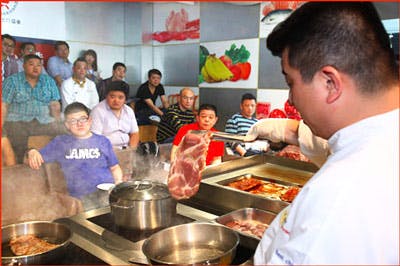Building Brand Awareness for U.S. Pork in China’s New Middle Class
Published: Jun 19, 2013
China has a voracious appetite for pork. On an average day, it consumes 1.9 million pigs. Combine that with the meteoric growth in China’s economy and middle class, and pork exporters around the globe are looking longingly at the world’s most populous country.

Celebrity chef Zhou Hua prepared recipes using five U.S. pork cuts
The market for pork exports to China has come a long way over the past 30 years. Before the global purchasing potential of China was broadly appreciated, USMEF established one of the first permanent offices there representing U.S. agriculture. Until the early 2000s, USMEF operated a unique meat school in Shanghai, complete with classrooms and dormitory, that provided training on U.S. meat production, grading and inspection, specifications and food safety.
“That legacy of long-standing relationships built with importers, food service operators and retailers is a major reason why top executive chefs from China’s best restaurants attend USMEF seminars today to learn about American red meat products and understand how different cuts can be incorporated into their menus and business models,” said Philip Seng, USMEF president and CEO.
“Of course, having the foremost expert on China’s meat trade, Joel Haggard, working on the U.S. industry’s behalf in China and Hong Kong for the last 25 years has given us an advantage over our competitors,” Seng said. The U.S. holds a commanding lead over Germany, Denmark and Canada as the No. 1 pork supplier to China.
Tapping into those long-standing relationships, USMEF recently assembled three dozen executive chefs from some of China’s top restaurants as well as leading pork importers for a workshop in Shanghai to give them a full immersion in U.S. pork.
For some of the chefs, this was their first in-depth exposure to high-quality grain-fed U.S. pork. They sampled boneless pork loin, bone-in butt, boneless CT butt, spare ribs and pork belly – steamed, deep fried, pan fried and grilled – prepared by celebrity chef Zhou Hua, who recently competed in Shanghai TV’s “Shanghai Food ACE” chef competition. Participants also received the U.S. industry’s message of product quality, food safety and quality assurance.

An enthusiastic group of Chinese executive chefs paid their own way to participate in the USMEF pork workshop
The seminar was so valuable that the attendees paid their entire cost of attending the program, which was supplemented with financial support from the Iowa Soybean Association and the Iowa Pork Producers Association. In fact, many of the chefs asked USMEF to conduct follow-up sessions.
“We were totally shocked and impressed by the quality and tenderness of U.S. pork,” said one executive chef. “These are great items that can be used in my restaurant. They will provide a wonderful choice for my customers.”
“The chefs gave U.S. pork rave reviews,” said Ming Liang, marketing manager for USMEF-Shanghai. “More than 94 percent rated the seminar as excellent, and 92 percent gave U.S. pork a perfect score of 5 out of 5 when compared to other supplying countries’ products.”
While its huge population (1.3 billion) makes China attractive to exporters, dramatic changes in the economic makeup of the country in recent years have added a sense of urgency. A mere 4 percent of Chinese urban households qualified as “middle class” as recently as 2000, according to a McKinsey & Company study, but that number exploded to 68 percent last year. That is driving more consumers to seek higher quality proteins. And pork is at the top of their shopping list.
“Twenty years ago – even 10 years ago – we would not have conducted U.S. pork branding awareness workshops for executive chefs from top-tier Chinese restaurants because pork was viewed as a commodity product,” said Haggard, USMEF’s senior vice president for the Asia-Pacific region. “Today, China has a developing pork brand awareness and a constantly growing number of outstanding restaurants. They are looking for the highest quality products to serve their customers.”
The China/Hong Kong region is the No. 3 market for U.S. pork exports. Through the first four months of 2013, it purchased 135,300 metric tons (298.3 million pounds) of American pork valued at $287 million.
